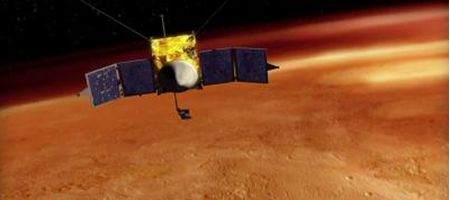NASA has given the green light to the development and 2013 launch of the Mars Atmosphere and Volatile Evolution (Maven) mission, which aims to investigate how Mars lost so much of its atmosphere.

Clues such as features resembling dry riverbeds and minerals that only form in the presence of liquid water suggest there was once water on the surface. The Maven mission will investigate whether the sun, and specifically the solar wind, is responsible for the loss.
“The team has successfully met every major milestone since selection two years ago,” said Maven project manager David Mitchell. “Looking forward, we are well positioned for the next push to critical design review in July 2011. In three short years, we’ll be heading to Mars!”
The team believes that the solar wind has been stripping the Martian atmosphere away, taking the water with it.
“Mars can’t protect itself from the solar wind because it no longer has a shield, the planet’s global magnetic field is dead,” said Bruce Jakosky of the University of Colorado, principal investigator for the project.
The solar wind and the sun’s ultraviolet radiation turns the uncharged atoms and molecules in Mars’ upper atmosphere into ions which are carried away by the electric fields generated by the solar wind.
But there are other possibilities: impacts by massive asteroids could have blasted large amounts of the Martian atmosphere into space. However, it’s thought that the huge Martian volcanoes that erupted after the impacts, like Olympus Mons, would have replenished the martian atmosphere by venting massive amounts of gas from the planet’s interior.
“Previous observations gave us ‘proof of the crime’ but only provided tantalizing hints at how the sun pulls it off — the various ways Mars can lose its atmosphere to solar activity,” said project scientist Joseph Grebowsky.
“Maven will examine all known ways the sun is currently swiping the Martian atmosphere, and may discover new ones as well. It will also watch how the loss changes as solar activity changes over a year.
Maven is scheduled for launch between November 18 and December 7 2013. If it is launched November 18, it will arrive at Mars on September 16, 2014 for its year-long mission.






